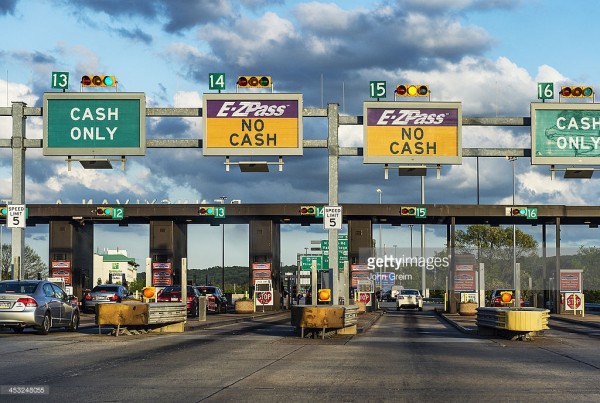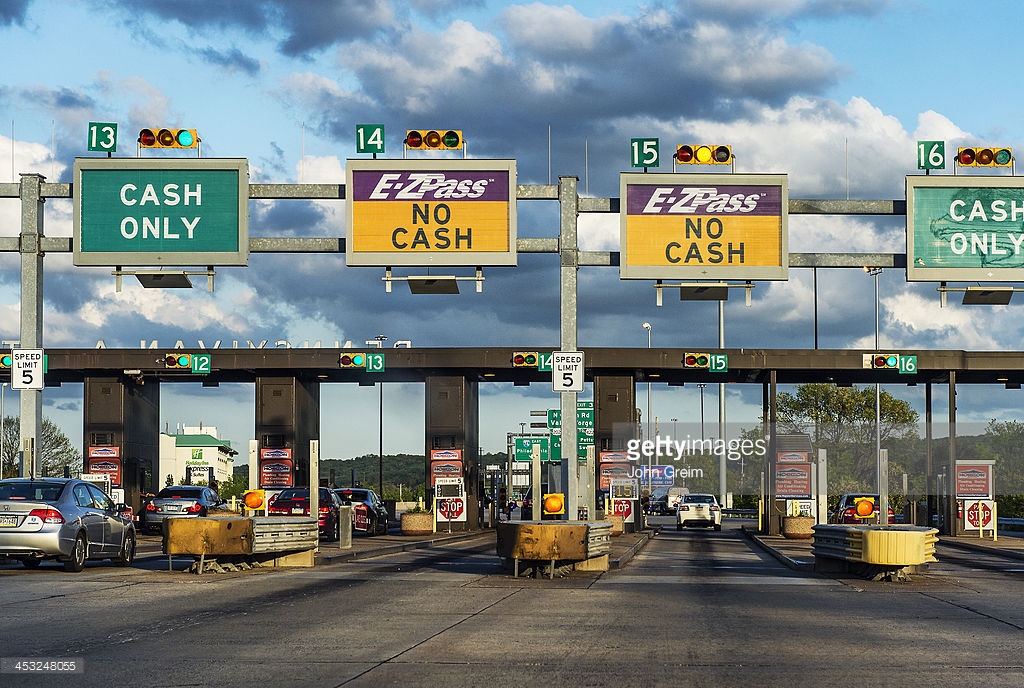
PHILADELPHIA, PENNSYLVANIA, UNITED STATES – 2012/04/20: E-Z Pass toll booth. (Photo by John Greim/LightRocket via Getty Images)
After a sudden rainstorm in drought-ravaged Southern California, a bridge collapsed near Palm Springs in July 2015. This bridge was part of Interstate-10, the fastest route between Los Angeles and Phoenix. The collapse injured a truck driver and stranded motorists for hours. It is estimated that this partial road closure will cost the Southwest 25 million dollars each day until the road can be fixed. While this may seem like a freak occurrence, it is emblematic of a serious issue facing America: the failure to maintain infrastructure.
The interstate system was built in the 1950s, and is now desperately in need of attention. This past unusually snowy winter has left many roads in the Northeast in need of serious repairs. Drivers are suffering through difficult commutes; potholes damage tires and craters create delays getting to work or to the store. While no one was killed when the I-10 collapsed, weaknesses in infrastructure have claimed lives. The deadly failure of the I-35 West Bridge over the Mississippi River in Minneapolis killed thirteen people and injured 145 others in 2007. If serious attention is not given to infrastructure, events like these may become more frequent.
Roads allow businesses and individuals to connect allowing for greater access to commodities and creating greater competition that benefits consumers. Sales produce tax revenues that the government can use to pay for road construction. Unfortunately, repairing existing infrastructure does not deliver the same return on investment as constructing new roads. The vendetta is how can the US repair and maintain aging roads without blowing the, already out of control, budget as well as without taking resources from other essential areas.
The cost of repairs need not be added to the growing national debt, which stands at $19,010,502,807,000. Increases in US oil production, a drop in Saudi prices, and growing competition by Canada, Iraq and Russia have brought gasoline to unusually low prices, with crude oil prices at roughly $28 a barrel coming down from a high of $125 a barrel in 2011. Although unpopular, it may be the right time to consider increasing the gasoline tax to produce revenue for repairs without seriously harming the American consumer. Americans use about 3.26 billion barrels of gasoline per year. A gas tax of thirty-five cents could raise billions of dollars in revenues for the needed repairs. However, fixing America’s infrastructure is estimated to cost $3.6 trillion so additional funds would need to be raised elsewhere.
Given the importance of a stable infrastructure, one would think repairs and maintenance to infrastructure would garner bipartisan support. While support can be found in both parties, some Republicans do not want the federal government to be involved in funding these projects. They believe that federal involvement in infrastructure maintenance would explode the national debt. Conservatives want the private sector to become responsible for infrastructure repairs. Privately funded highways are common in Asia and Europe. Private companies bear the cost and responsibility for maintaining the highway. Then the company charges a toll to recoup its costs and make a profit. Milton Friedman argued that private investments in infrastructure would lead to greater caution and safer results than publicly maintained roads. Along with private companies building and maintaining the roads these companies would provide local jobs in construction and engineering that would stimulate the American economy. A few private infrastructure projects have begun in the United States. After the I-35 West Bridge failed in Minneapolis, local authorities could not obtain the public funds to replace it. A private company, the FIGG Engineering Group, designed the I-35W Saint Anthony Falls Bridge. They designed, funded, and operate the bridge. They will recoup their $140 million through tolls.
President Obama attempted to increase infrastructure spending in 2011. He received widespread Republican opposition. Although the Republican Party represents fiscal responsibility and a smaller federal role in the economy, resistance to infrastructure spending clashes with the history of the GOP and Republican desire to promote business. President Eisenhower championed the Interstate highway system. President Theodore Roosevelt built the Panama Canal and President Lincoln built the transcontinental railroad. While concerns about the national debt are important, and repairing America’s infrastructure will be expensive, it will be even more expensive to let things crumble. Unless our leaders start to make serious progress in funding the needed repairs, it is likely we will see additional infrastructure collapses resulting in economic hardship and lost lives.
Take Action: To support the necessary investment to repair America’s infrastructure, sign the petition to the “MoveOnPetitions” organization. http://pac.petitions.moveon.org/sign/support-big-investment




